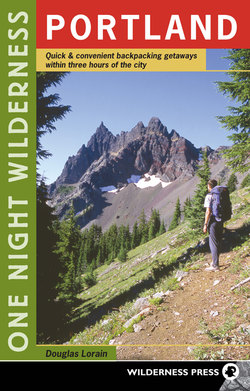Читать книгу One Night Wilderness: Portland - Douglas Lorain - Страница 13
На сайте Литреса книга снята с продажи.
1 Duckabush River Trail
Оглавление| RATINGS | Scenery 5 Difficulty 2 to 6 Solitude 6 | |
| ROUND-TRIP DISTANCE | 4.4 miles to first camp; 13.4 miles to park boundary | |
| ELEVATION GAIN | 900 feet to first camp; 2800 feet to park boundary | |
| OPTIONAL MAP | Green Trails: The Brothers | |
| USUALLY OPEN | April to November | |
| BEST TIMES | Late April to June/October | |
| AGENCY | Hood Canal Ranger District (Olympic National Forest) | |
| PERMIT | Park service permit required if you camp beyond 6.7 miles from the trailhead. Permits cost $5 to register your group, plus $2 per person per night. Contact the park’s wilderness information center for permits. Northwest Forest Pass required. |
Highlights
Although it features some exceptionally nice views along the way, the Duckabush River Trail is primarily a forest hike that follows one of the largest and most important rivers flowing out of the eastern Olympic Mountains. Since the trail is open for most of the year, this is a particularly good choice for a spring or fall adventure, when the higher mountains are still encased in snow.
Getting There
Drive 110 miles north of Portland on Interstate 5 to Olympia and take Exit 104 for U.S. Highway 101. After 6 miles, exit to the right, staying on Highway 101, and then drive 50 miles to a junction with paved Duckabush River Road near Milepost 310. Turn left (west), drive 6.1 miles on pavement then good gravel to a junction, bear right, and reach the road-end trailhead after another 0.2 mile.
Hiking It
The gravel-strewn trail begins on a hillside well away from the river as it makes a gentle climb through a forest of Douglas firs and western hemlocks. After gaining 450 feet in 1.2 miles, the trail reaches the relatively unimpressive top of a rocky spur called Little Hump. From here you descend all the way to the river and walk across lush river-level flats filled with old stumps (testament to the logging that once occurred here) and a vigorous second-growth forest of Douglas firs, maples, and countless thousands of ferns. At 2.2 miles is an excellent campsite beside the clear Duckabush River. If you are backpacking with children, this is a good place to spend the night.
Beyond the first camp you face the trip’s biggest obstacle, a 1000-foot climb over the top of Big Hump. This rocky mass, which was left behind by ancient glaciers, requires two dozen short, fairly steep, and rather tiring switchbacks to conquer. Fortunately, partway up is a perfect rest stop at a fine overlook with a superb view of the forested Duckabush Valley. Across the valley to the south rises prominent St. Peters Dome, whose towering sheer sides make it look as if it were transplanted from California’s Yosemite Valley. Beyond this viewpoint more uphill takes you past a nice but not as impressive viewpoint before you come to the indistinct top of Big Hump in viewless forest.
It is nearly all downhill from here as switchbacks descend 700 feet to the cascading Duckabush River just above where the water cuts a gorge around Big Hump. Not far upstream is Five Mile Camp (actually at 5.2 miles, but close enough), a comfortable site with room for a few tents. Beyond here the trail stays in valley forests, making many small ups and downs but never straying too far from the water. There are several possible campsites along the way, but if you go beyond 6.7 miles, where the trail enters the national park, you will need a Park Service permit to spend the night. The park also prohibits firearms and pets. Hardy hikers can continue their wilderness adventure, reaching lovely Ten Mile Camp at (you guessed it) a little over 10 miles, and eventually climbing to the gorgeous high meadows and lakes around Marmot Lake and O’Neil Pass. Both of these destinations are more than 20 miles into the heart of the glorious Olympic backcountry.
St. Peters Dome from Duckabush River Trail, Olympic National Forest
